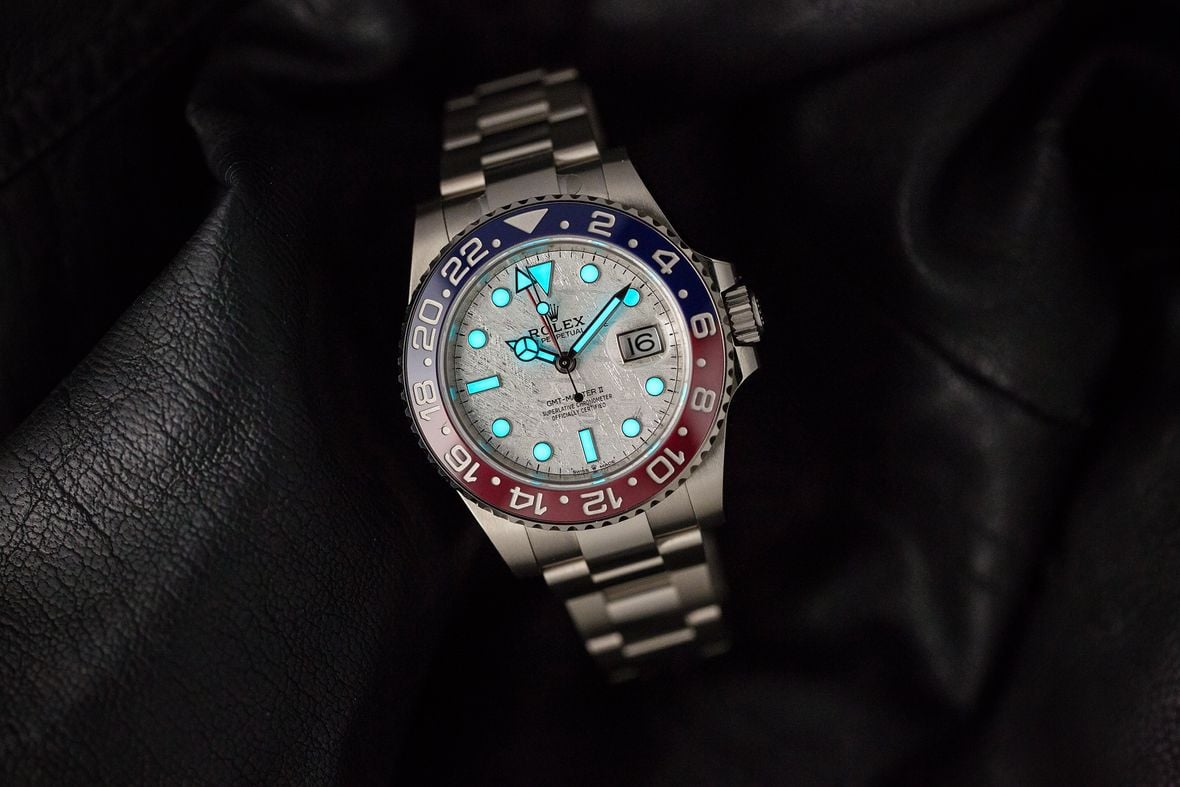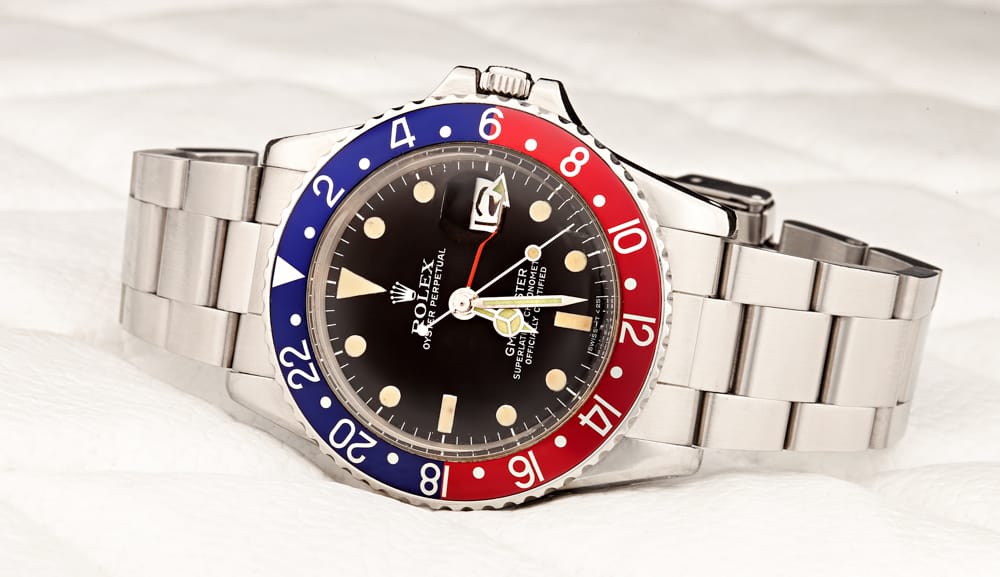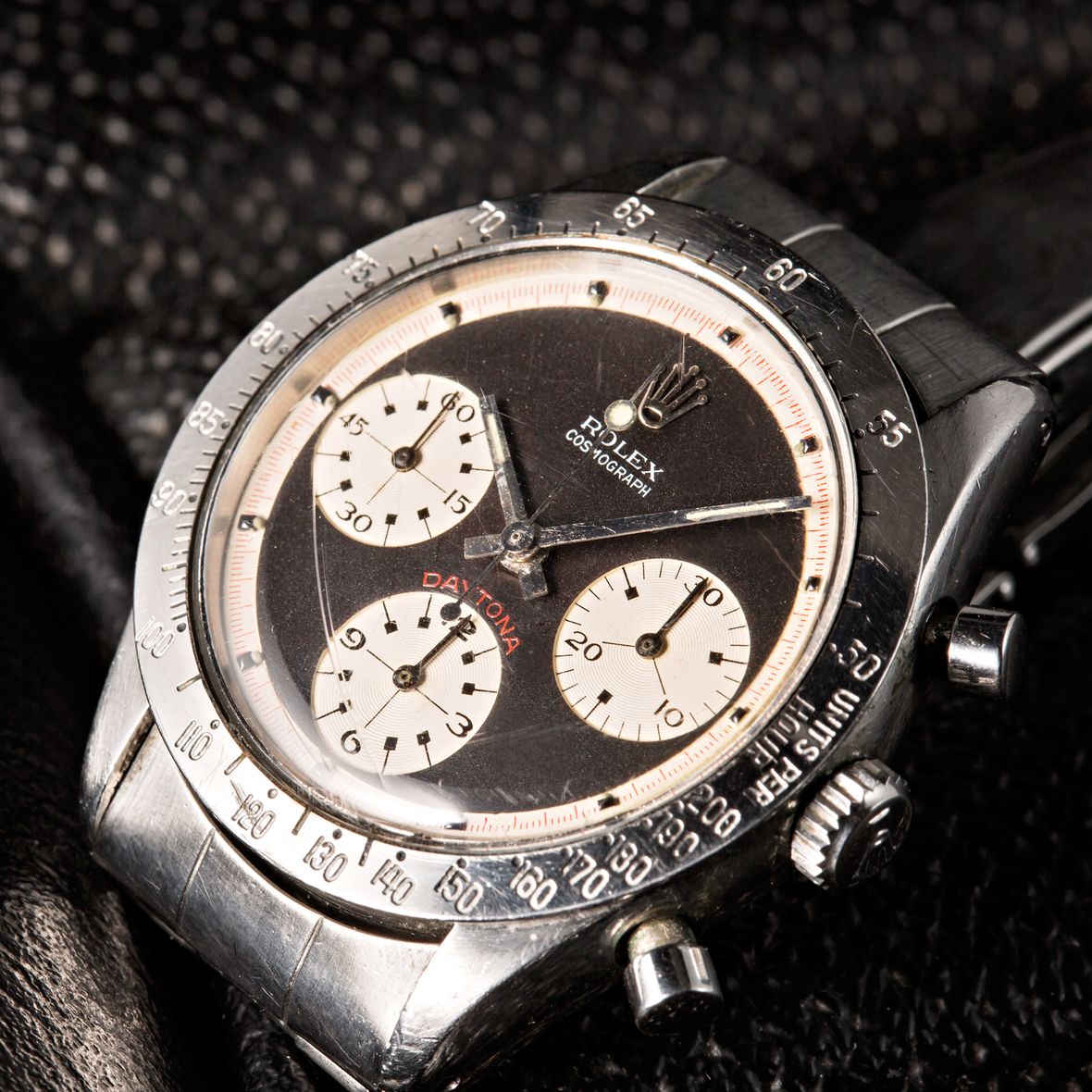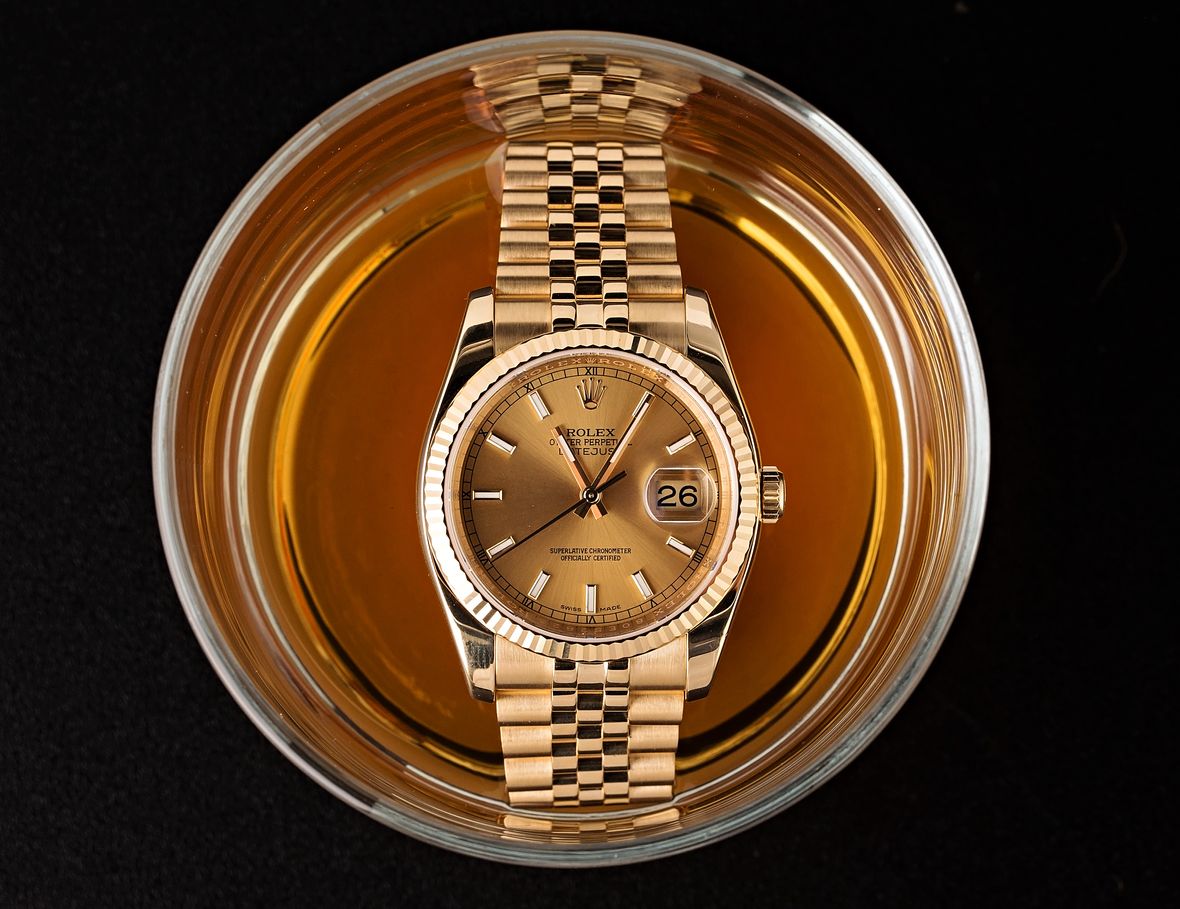Say the word “Pepsi” to an average person and more likely than not, they’ll picture a can of the famous sugary red and blue soda can. Say the same name to a watch enthusiast, however, and their first thought will have nothing to do with a drink. Rather, they’ll likely imagine the equally famous Rolex pilot’s watch with a bi-color bezel. Of course, we are talking about the Rolex GMT-Master and the iconic blue and red bezel nicknamed the “Pepsi.”
The Rolex Pepsi has been around since the GMT-Master’s debut in the mid-1950s. In fact, Rolex has made the blue and red bezel in Bakelite, aluminum, and now, Cerachrom ceramic. While today’s GMT-Master II is quite different from the ones of yesteryear, there are some common design traits and functionality and unites all generations of this instantly recognizable timepiece designed for international travel. So let’s delve into the history, evolution, and progression of the blue and red bezel of the famous pilot’s watch with this ultimate guide to the Rolex GMT Pepsi.
Rolex Pepsi History
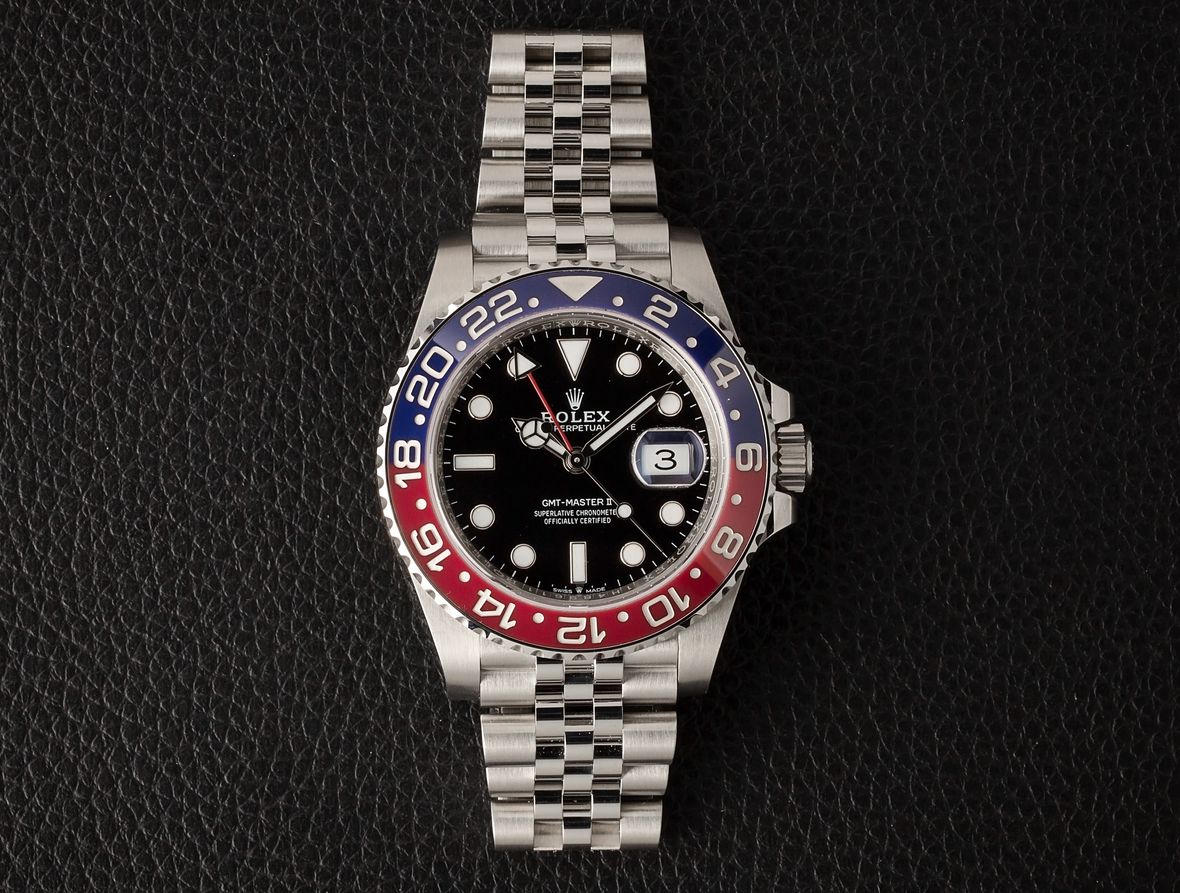
Important Dates in Rolex GMT Pepsi History:
- 1955: Rolex introduces the GMT-Master 6542 with a blue/red Bakelite bezel.
- 1959: Rolex releases the GMT-Master Ref. 1675 and replaces Bakelite with aluminum.
- 1981: Rolex releases the GMT-Master Ref. 16750.
- 1988: Rolex releases the GMT-Master 16700, the last GMT-Master reference.
- 1989: Rolex releases the GMT-Master II 16710, the second generation GMT-Master II and offers the Pepsi bezel as an option.
- 2014: Rolex releases the GMT-Master II 116719BLRO, the first white gold GMT and the first Pepsi bezel in Cerachrom.
- 2018: Rolex releases the GMT-Master II 126710BLRO with a Jubilee bracelet, the first steel GMT with a Cerachrom Pepsi bezel.
- 2018: Rolex releases the GMT-Master II 126719BLRO.
- 2021: Rolex releases GMT-Master II 126710BLRO with an Oyster bracelet.

Rolex Pepsi Reference Numbers
Although the red and blue bezel is – without a doubt – the most famous colorway of the GMT-Master lineup, it has not always been available with every reference. For example, when Rolex debuted the GMT-Master II in the early-1980s, it was exclusively offered with a black and red bezel, aptly nicknamed “Coke.”
Additionally, when Rolex introduced the new-generation GMT-Master II watches with Cerachrom ceramic bezels in 2005, it took almost a decade to create one in blue and red – and it was initially only available on a white gold model. Speaking of which, the blue and red bezel, also known as the BLRO (short for “bleu” and “rouge”), are only made for GMT-Master and GMT-Master II watches in steel or white gold and never for yellow gold, rose gold, or two-tone steel and gold models.
Here are all the different Rolex GMT-Master and Rolex GMT-Master II watch references that have been made available with a red and blue Pepsi bezel. If you’re shopping for one of these used Rolex watches for sale, be sure to first browse our collection page.
GMT-Master Ref. 6542
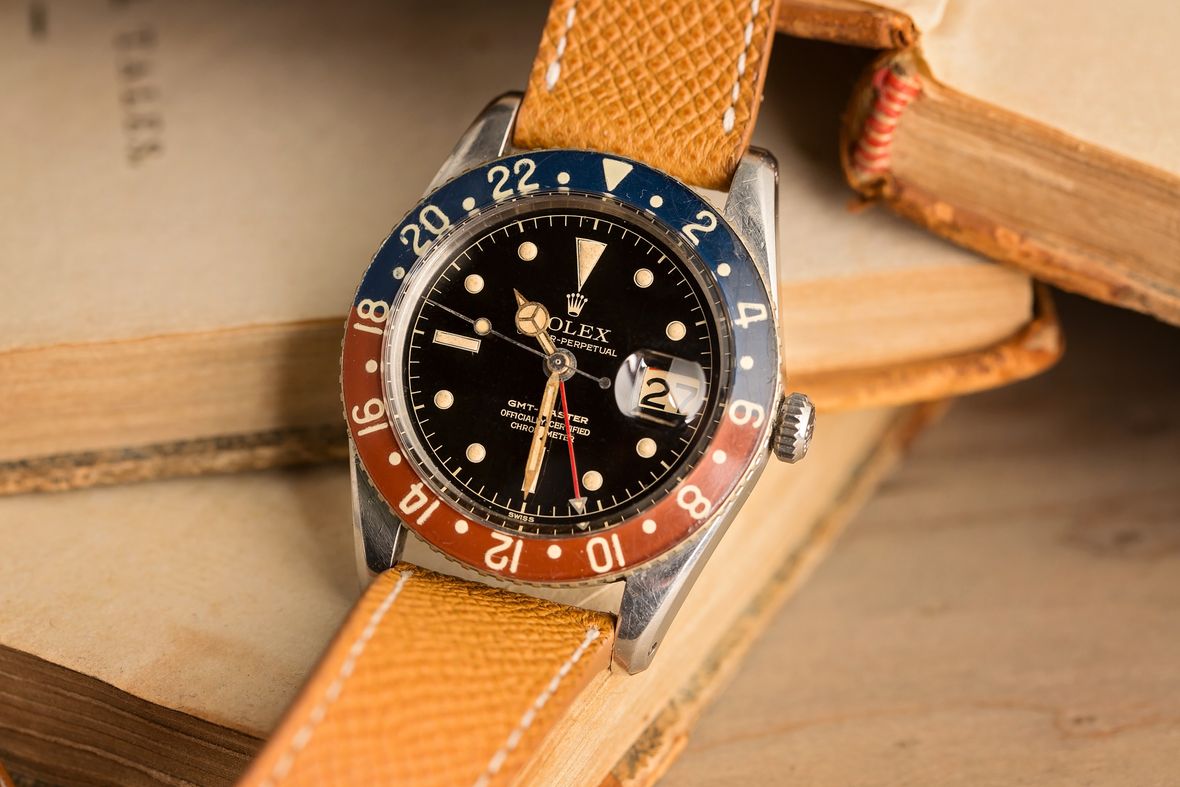
Pepsi GMT-Master 6542 Key Features:
- Production Years: 1955 – 1959
- Stainless steel 38mm case
- Bakelite Pepsi bezel
- Caliber 1036, 1065, and 1066
Rolex unveiled the first GMT-Master in 1955, designed specifically for Pan American airline pilots. Along with the traditional 12-hour hand on its dial, the GMT-Master also featured a 24-hour hand, which in conjunction with the rotating 24-hour bezel, could display another time zone. Therefore, the GMT-Master allowed pilots to read two time zones at once, which were typically set to local time and standard time. Greenwich Mean Time (GMT) was the international civil time standard (Coordinated Universal Time or UTC replaced it in 1972), which explains why Rolex named the watch after it.
The first reference to launch the collection was the Rolex GMT 6542, fashioned from stainless steel and topped with a Bakelite blue and red bezel. The choice of a two-tone bezel was done to help wearers quickly differentiate between day and night hours of the second time zone. Unfortunately, Bakelite did not prove to be the best material for the job as it tended to crack. Plus, the glowing radium numerals that Rolex set into these Bakelite inserts were a potential radiation hazard, which caused Rolex to replace Bakelite with aluminum for the material of the Pepsi insert before the end of the ref. 6542’s production. Finding a GMT-Master 6542 with an original Bakelite Pepsi bezel is quite the challenge as it’s one of the most collectible vintage Rolex watches on the market.
GMT-Master Ref. 1675
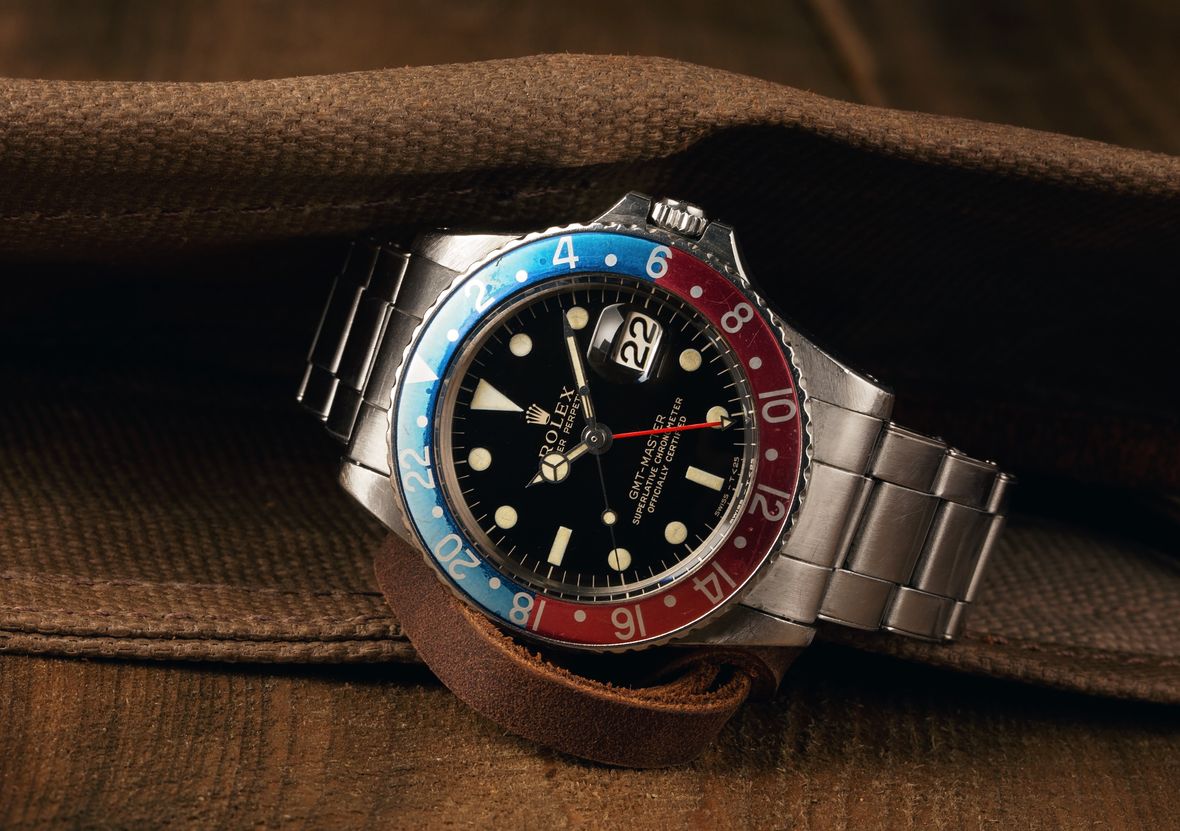
Pepsi GMT-Master 1675 Key Features:
- Production Years: 1959 – 1980
- Stainless steel 40mm case with new crown guards
- Aluminum Pepsi bezel; all-black bezel insert followed later
- Gilt-gloss dials (until about 1966) or matte black dials
- Radium (until about 1964) or tritium lume
- Caliber 1565 or 1575
Launched in 1959, the Rolex GMT-Master 1675 was the second generation of the brand’s pilot watch. This time, Rolex opted to fit the watch with an aluminum bezel insert from the start rather than brittle Bakelite. Similar to its predecessor, the GMT-Master 1675 was made in stainless steel and featured a blue and red Pepsi bezel. However, new to the model was the introduction of crown guards and a larger 40mm case size. Other variations, such as gold models with brown bezels and steel models with all-black bezels followed later.
Rolex produced the GMT-Master ref. 1675 until 1980, making it one of the longest-running references in the brand’s history. As such, there are quite a few variations between the early ref. 1675 watches and later ones, including dials (gilt-gloss versus matte black with printing), lume type (radium was replaced by tritium in the mid-1960s), and movements (cal. 1565 or cal. 1575.) Additionally, Rolex added the hacking feature (where the seconds hand stops when the crown is pulled out) in 1971.
It’s not uncommon for GMT-Master 1675 Pepsi watches to have very faded bezels. Some have turned into light blue and light pink, while others have a section that has transformed into a stunning fuchsia shade.
GMT-Master Ref. 16750
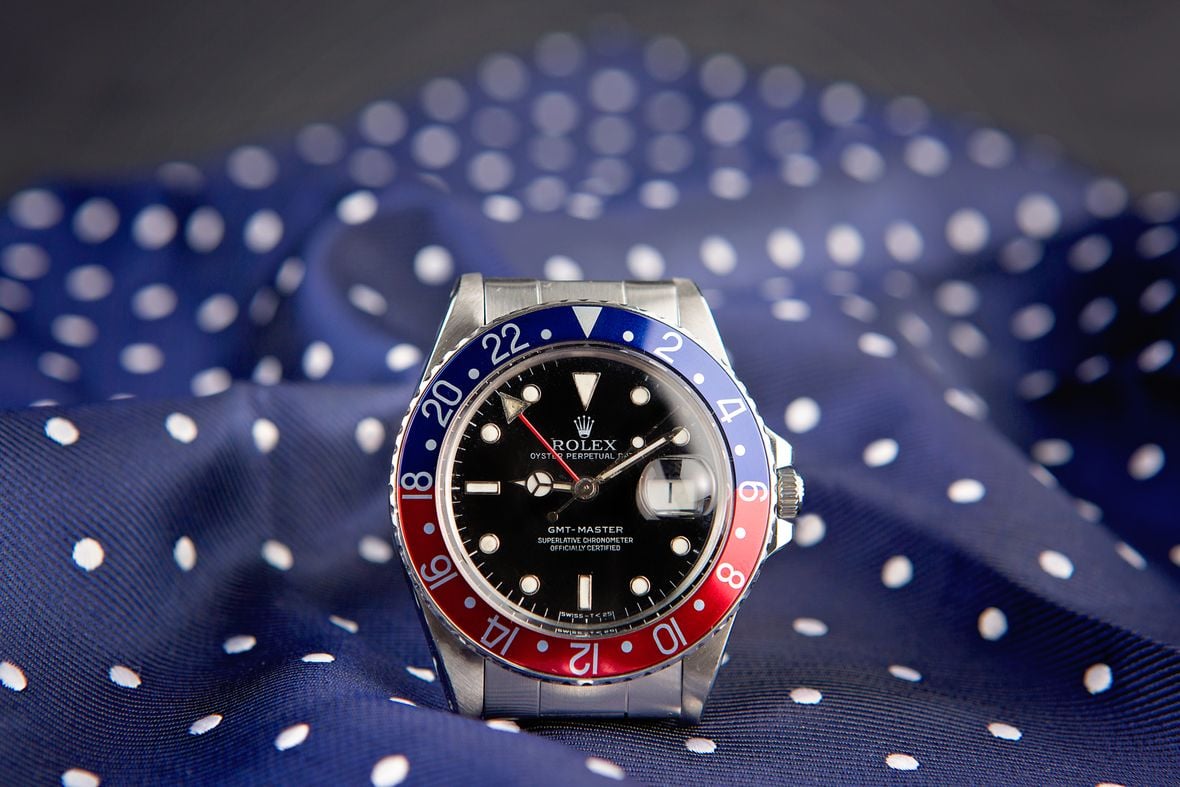
Pepsi GMT-Master 16750 Key Features:
- Production Years: 1980 – 1988
- Stainless steel 40mm case
- Aluminum Pepsi bezel or black bezel
- Matte dials or glossy dials
- Tritium lume
- Caliber 3075 with quickset date
Launched in 1980, the vintage Rolex 16750 replaced the ref. 1675 and was in production until 1988. The GMT-Master ref. 16750 is considered a transitional reference as it was produced for less than a decade and introduced a few notable updates.
New to the ref. 1675 was the Rolex Caliber 3075 movement with the quickset date function. A quickset allows the date to be set independent of the hour hand – a supremely practical feature for any type of watch. Furthermore, the hacking feature was standard across all ref. 16750 models given that it was introduced the previous decade to the ref. 1675. Finally, the reference 16750 boasted double the water-resistance of its predecessors at 100 meters (330 feet).
While early versions of the GMT-Master ref. 16750 retained the matte dials of the previous 1675, Rolex quickly switched to glossy dials with white gold surrounds for the hour markers. Rolex offered the stainless steel GMT-Master 16750 with both the blue and red Pepsi bezel as well as the all-black bezel insert.
GMT-Master Ref. 16700
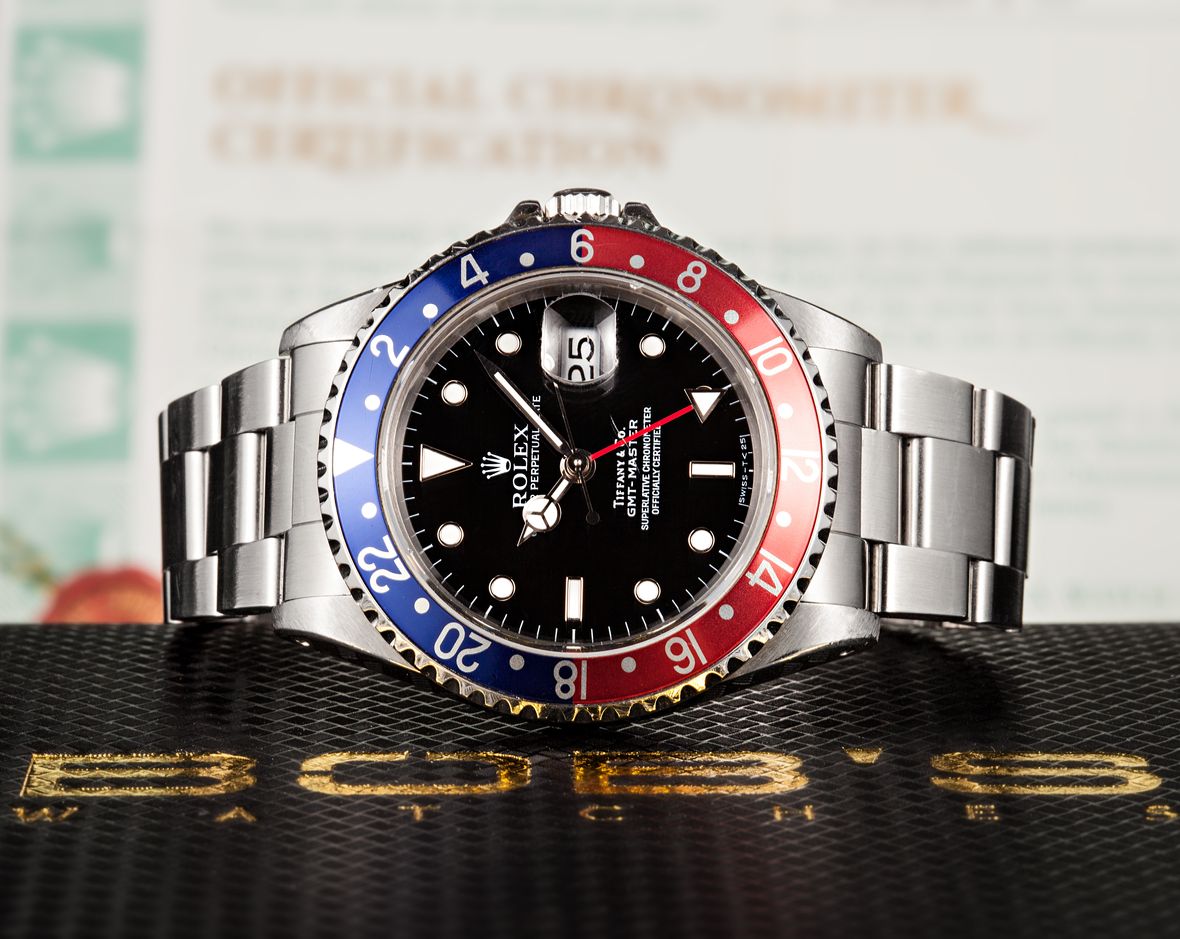
Pepsi GMT-Master 16700 Key Features:
- Production Years: 1988 – 1999
- Stainless steel 40mm case
- Aluminum Pepsi bezel or black bezel
- Sapphire crystal
- Glossy dials
- Tritium lume (up until 1997) or Luminova lume
- Caliber 3175
The Rolex 16700 was the last GMT-Master watch made. It was produced from 1988 until 1999, after which Rolex dropped the GMT-Master line entirely in favor of the GMT-Master II. The major difference between the GMT-Master and GMT-Master II is that the latter featured independently adjustable 12-hour and 24-hour hands, which means that the wearer could set the second time zone with just the hands, freeing up the rotating bezel for users to quickly access a third.
While Rolex had already introduced the GMT-Master II in 1982, it released the GMT-Master 16700 as the more affordable alternative. The GMT-Master 16700 was exclusively available in stainless steel and came fitted with either a blue and red Pepsi bezel or an all-black one.
New to the GMT-Master 16700 was a sapphire crystal instead of an acrylic one and the Caliber 3175 movement. Earlier versions of the GMT-Master 16700 will have tritium as the lume on their dial; Rolex switched to Luminova around 1997.
GMT-Master II Ref. 16710
Pepsi GMT-Master II 16710 Key Features:
- Production Years: 1989 – 2007
- Stainless steel 40mm case
- Aluminum Pepsi bezel, Coke bezel, or black bezel
- Sapphire crystal
- Glossy dials
- Tritium, Luminova, or Super-Luminova lume
- Caliber 3185 or Caliber 3186
The Rolex ref. 16710 is the second model of the GMT-Master II collection. It replaced the GMT-Master II 16760 in 1989 and was in production until 2007. The GMT-Master II 16710 had a slimmer design over the older ref. 16760 and was made available with three types of bezels: black and red, all-black, and, of course, red and blue – the Pepsi.
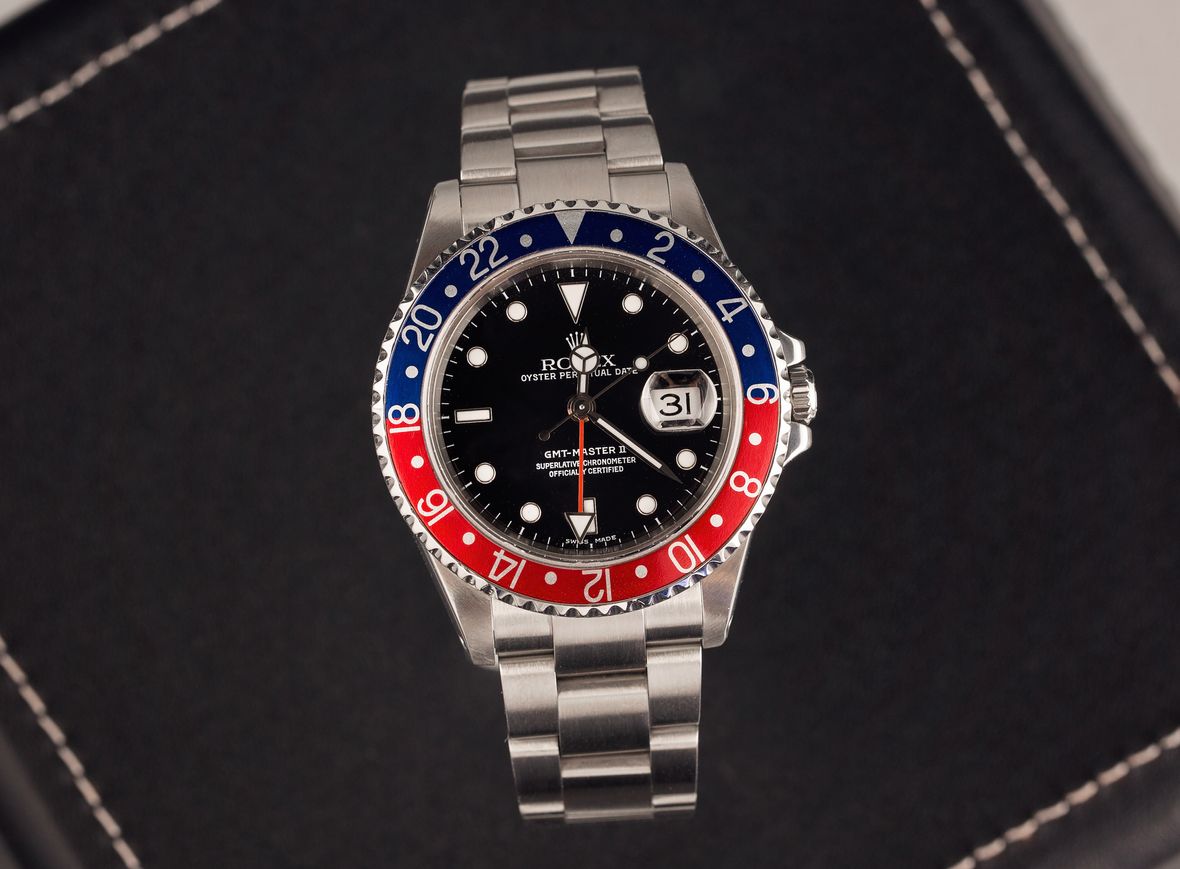
Over its almost twenty-year run, the Rolex 16710 underwent several modifications including lume updates. There was also the inclusion of bracelet solid end-links in 2000 and the elimination of visible lug holes on the case around 2003. Moreover, the very last GMT-Master II 16710 watches that came out of the factory in 2007 were equipped with the Caliber 3186 movement instead of the Caliber 3185.
The Rolex GMT-Master II 16710 would also be the last reference to have a Pepsi bezel made from anodized aluminum – and it would be another 11 years until Rolex would make a steel version of its iconic travel watch that would have a red and blue “Pepsi” bezel.
GMT-Master II Ref. 116719BLRO
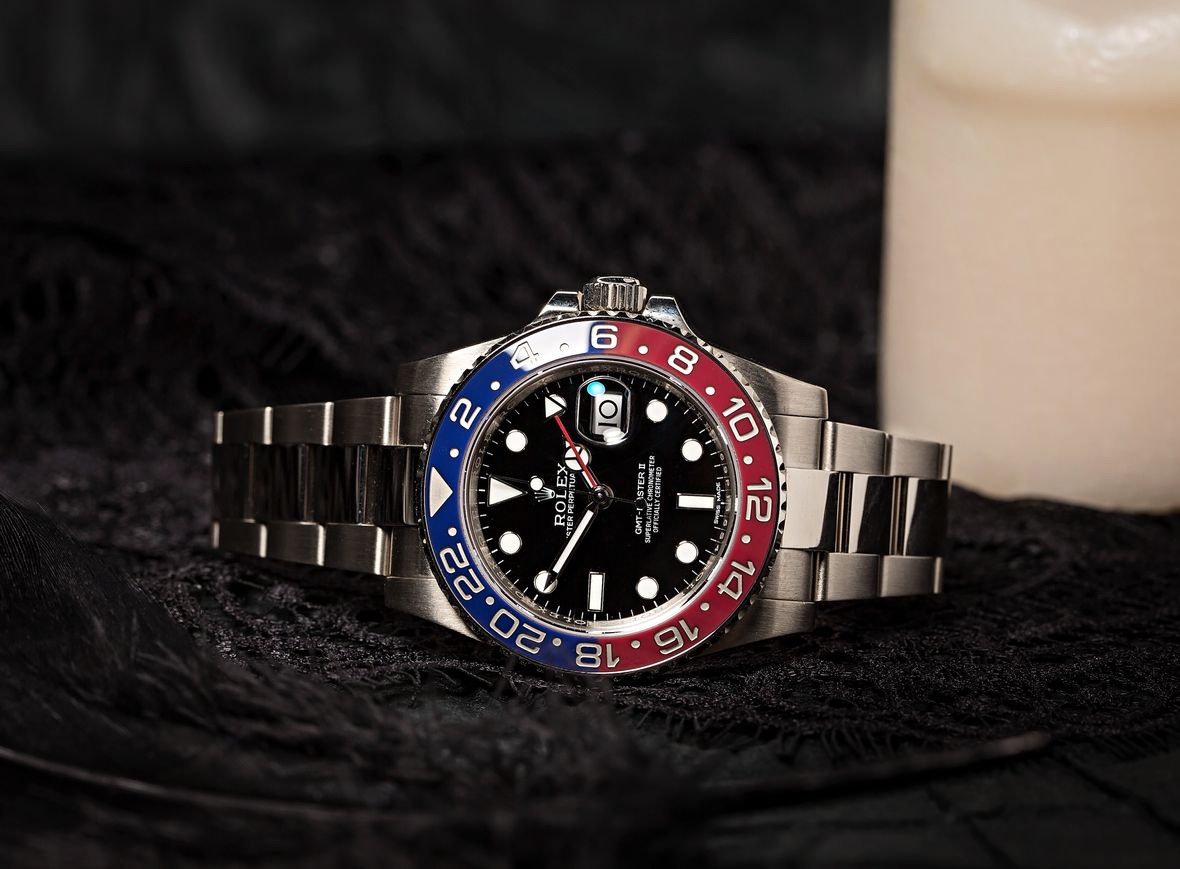
Pepsi GMT-Master II 116719 BLRO Key Features:
- Production Years: 2014 – 2018
- White gold 40mm case
- Cerachrom Pepsi bezel
- Chromalight lume
- Oyster bracelet
- Caliber 3186
Rolex launched the GMT-Master II ref. 116719 in 2014 as the first white gold model of the collection. The GMT-Master II ref. 116719BLRO marked the return of the blue and red Pepsi bezel after a seven-year absence; however, the bezel was now crafted from Cerachrom (Rolex’s proprietary ceramic alloy) rather than aluminum like the previous generation.
According to Rolex, producing a two-tone Cerachrom bezel is an arduous challenge, which is why the brand had formally stated that it couldn’t be done. Cerachrom-clad GMT-Master II watches that debuted in 2005 (yellow gold,) 2006 (yellow Rolesor,) and 2007 (stainless steel) only came with all-black bezels. It wasn’t until 2013 that a two-tone Cerachrom in blue and black came onto the scene, followed by a two-tone Cerachrom blue and red Pepsi the following year.
Rolex had succeeded in doing the alleged impossible and the Pepsi bezel made a triumphant return. However, given that the Rolex GMT-Master II 116719BLRO is a model crafted from solid 18k white gold, it represents a significant price increase compared to stainless steel models, making it out of reach for many collectors.
The Rolex GMT-Master II 116719 retained the traditional 40mm case size, yet thanks to fatter lugs, a wider bezel, and a thicker profile, it wears larger than older Pepsi GMT-Master models. For legibility in the dark, the GMT-Master II ref. 116719BLRO includes the newest Rolex Chromalight lume, which glows blue for up to eight hours. Finally, powering the GMT-Master II ref. 116719 is the Caliber 3186 movement with a blue Parachrom hairspring that can better withstand temperature variations and higher magnetic fields.
GMT-Master II Ref. 126710BLRO
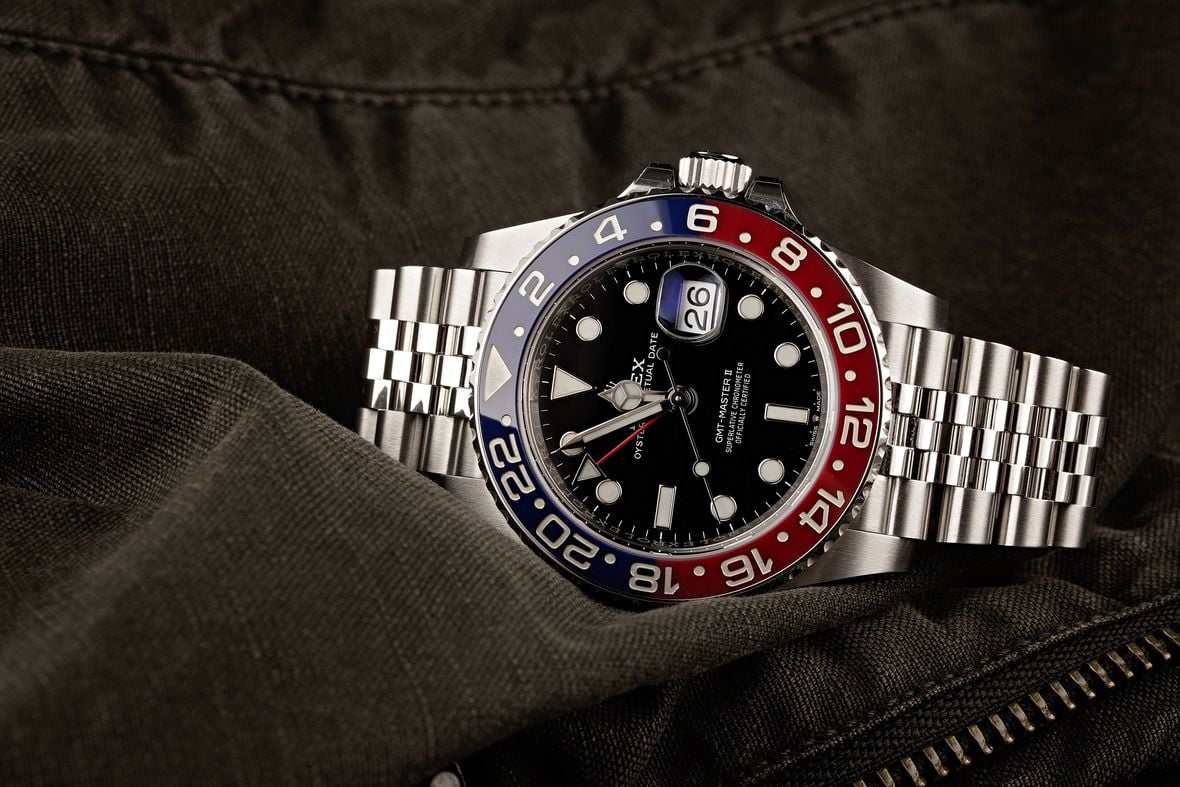
Pepsi GMT-Master II 126710 BLRO Key Features:
- Production Years: 2018 – present
- Oystersteel 40mm case
- Cerachrom Pepsi bezel
- Chromalight lume
- Jubilee or Oyster bracelet
- Caliber 3285
2018 was a big year for the GMT-Master II collection — not only were there big changes announced for the entire lineup but it also saw the return of a steel Pepsi GMT in the form of the Rolex 126710.
The GMT-Master II ref. 126710BLRO features a 40mm Oystersteel (Rolex’s branded 904L stainless steel alloy) topped with a blue and red Cerachrom bezel. Its case features slightly slimmed-down lugs compared to the 11671x generation of GMT-Master II watches. The new-generation Caliber 3285 movement brings all of the most up-to-date Rolex movement technology into the GMT caliber; among other things, increasing its power reserve to a healthy 70 hours.
Almost as fast as the gleeful comments came pouring in applauding the new Rolex GMT watch, another camp of commentators began growing and contesting. Looking beyond the Pepsi bezel, the new Rolex GMT-Master II revealed another surprise – a steel Jubilee bracelet and only that bracelet option for the stainless steel Pepsi GMT model.
Rolex has already fitted the GMT-Master with a Jubilee bracelet in the past, but that was over a decade ago. Additionally, the Jubilee bracelet was not just an option on the GMT-Master II 126710BLRO to be offered alongside the sportier Oyster bracelet; it was the only way Rolex was offering its new stainless steel GMT model. After all, there needs to be an obvious way to differentiate between the white gold GMT-Master II “Pepsi” and the significantly less costly steel GMT-Master II version.
However, in 2021, Rolex finally announced that the stainless steel GMT-Master II 126710BLRO Pepsi would now also be available with a sportier three-link Oyster bracelet in addition to the Jubilee, meaning that buyers would once again have a choice in bracelet style when shopping for a stainless steel Pepsi Rolex GMT watch. As you might imagine, that news has made many Pepsi GMT enthusiasts tremendously happy; however, the one downside is that it has only made waiting lists for the watch even longer at authorized retailers, who were already entirely sold out of the model prior to the latest update to the collection.
GMT-Master II Ref. 126719BLRO
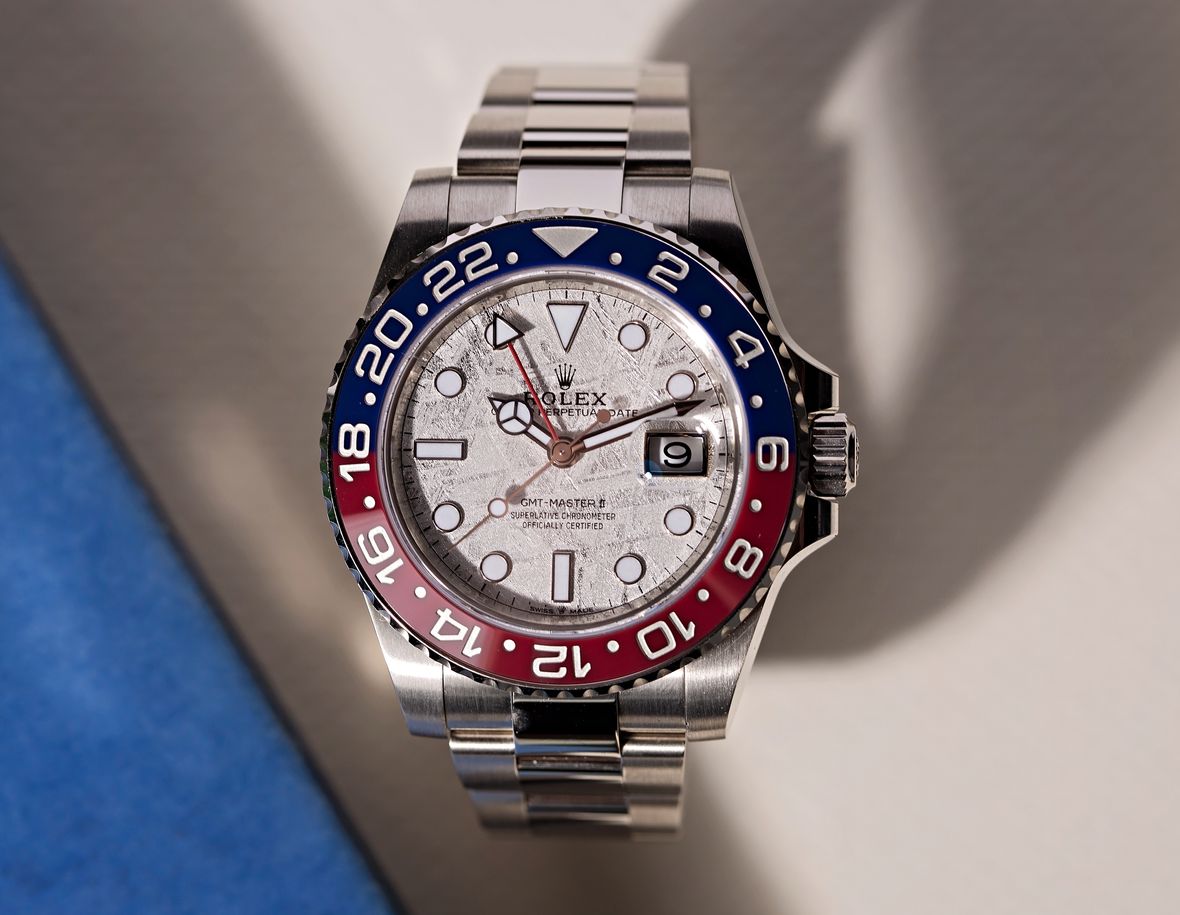
Pepsi GMT-Master II 126719 BLRO Key Features:
- Production Years: 2018 – present
- White gold 40mm case
- Cerachrom Pepsi bezel
- Blue or meteorite dial
- Chromalight lume
- Oyster bracelet
- Caliber 3285
Rolex also upgraded its white gold Pepsi model by releasing the Rolex 126719 in 2018. Similar to the stainless steel Pepsi variant, the updated ref. 126719BLRO runs on the new-gen Caliber 3285 automatic movement and benefits from slightly thinner and more refined lugs.
The first version of the GMT-Master II ref. 126719BLRO came fitted with a dark blue dial, which matches nicely with the deep blue portion of its Cerachrom Pepsi bezel. The following year, Rolex added a stunning meteorite dial as an option; the watch’s similarity to the mythical and ultra-rare vintage GMT Master ref. 6542 “Albino” is hard to miss, although the meteorite dial and the full white gold construction of the case and bracelet elevate the reference 126719BLRO to an entirely more luxurious level that places it in the “statement watch” category of luxury timepieces.

Final Review of Rolex Pepsi Models
Although the Rolex GMT-Master bezel has had several dual-color variations throughout the decades – black and red (“Coke”), blue and black (“Batman”), and brown and gold (“Root Beer”) – the iconic blue and red “Pepsi” colorway remains the version most associated with the collection.
Whether crafted from Bakelite, aluminum, or Cerachrom, the classic red and blue Pepsi bezel is the classic choice for a Rolex GMT watch. It looks great on top of a vintage stainless steel GMT-Master or a modern 18k white gold GMT-Master II and looks equally at home when paired with either an Oyster or Jubilee bracelet.
Throughout most of Rolex’s history, the brand has generally adhered towards more classic and conservative colors for its watches, such as silver, black, white, and champagne. Bright red and blue are hardly the first colors that come to mind when you think of a timeless and classic watch design, yet the Rolex Pepsi GMT is proof to the contrary, as it has been a staple of the watch industry for well over half a century. The combination of the blue and red sections, punctuated by large white numerals, has played a paramount role in making the GMT-Master one of Rolex’s most recognizable – and popular – watches ever made.
